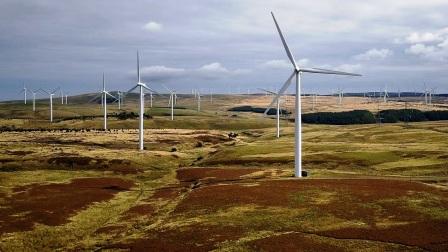Scotland had some major wins in its booming renewable energy sector during the first month of 2025, but industry groups warn that proposals to split the UK’s electricity market so that prices differ by region risk deterring future investment.
In early January, Copenhagen Infrastructure Partners said it will invest about £800m to build two of Europe’s largest battery energy storage systems (BESS) in South Lanarkshire and Fife, each with power capacity of 500MW. The Danish firm claims it is now the UK’s largest BESS investor, with a total planned power capacity of 1.5GW across three BESS projects of equal size.
Several others confirmed in January progress on their plans in Scotland, such as Germany’s Energikontor receiving permits to build three projects with a combined capacity over 200MW. Norway’s Fred Olsen Renewables also launched proposals to develop a 158MW wind farm in the Scottish Highlands region with up to 22 turbines and 30MW of battery storage.
Despite dipping from a peak in 2022, Scotland’s renewables still attracted more than $10bn in greenfield foreign direct investment announcements in 2024, according to fDi Markets.
Scotland’s high wind speeds, large bodies of water and mountainous terrain have since 2022 led to investment pledges worth billions of dollars from renewable energy developers, including in onshore and offshore wind farms, solar parks and pumped hydro storage projects. These plans have come after successful annual UK auctions of government contracts, known as contracts for difference (CfDs), which guarantee developers electricity prices for 15 years.
But industry groups argue that a review of electricity market arrangements (REMA) has created uncertainty over the viability of future renewables projects in Scotland. Launched in 2022 under the previous Conservative UK central government, REMA would split the UK into regional electricity markets. This would mean wholesale electricity prices would differ by region, depending on supply and demand, rather than the current system of a single national wholesale price. This has the potential to make some existing investments unviable once their guaranteed CfD expires after 15 years.
“Zonal pricing would actively disincentivise the development of wind farms and other renewable energy technology in Scotland, derailing progress towards net zero and meaning Scotland would miss out on its most significant economic opportunity in decades,” says Andrew MacNish Porter, head of economics and markets at Scottish Renewables, a local industry trade body. He adds that the industry “is currently under serious threat” from the proposed reforms.
In 2022, Scotland successfully undertook ScotWind, the world’s largest seabed leasing round for commercial offshore wind farms. This led to total investment commitments of £28.8bn by developers across 20 projects.
One ScotWind investment, a joint venture between ESB and Red Rock, confirmed in January that they had raised more than £3.5bn for its planned 1.08GW Inch Cape Offshore Wind Farm. Its turbines will be supplied by Denmark’s Vestas, which is seeking to build Scotland’s first blade manufacturing facility near Edinburgh.
“There is an encouragement for developers in the UK to use more local content, incentivising companies to build factories here,” says Simon Wallace, head of offshore wind at Scottish Development International, the country’s inward investment agency.
The UK aims to achieve 60% local content in its offshore wind projects by 2030, with active support for fledgling projects.
While uncertainty remains over zonal pricing, Scotland captured 18 out of 22 CfDs awarded for onshore wind farms in the sixth CfD round published in September 2024. “We still expect a tsunami of ScotWind projects in years to come, and that gives us confidence for greater investments this coming year,” says Mr Wallace, referring to the CfD allocation round 7 being held later in 2025.
fDi



























